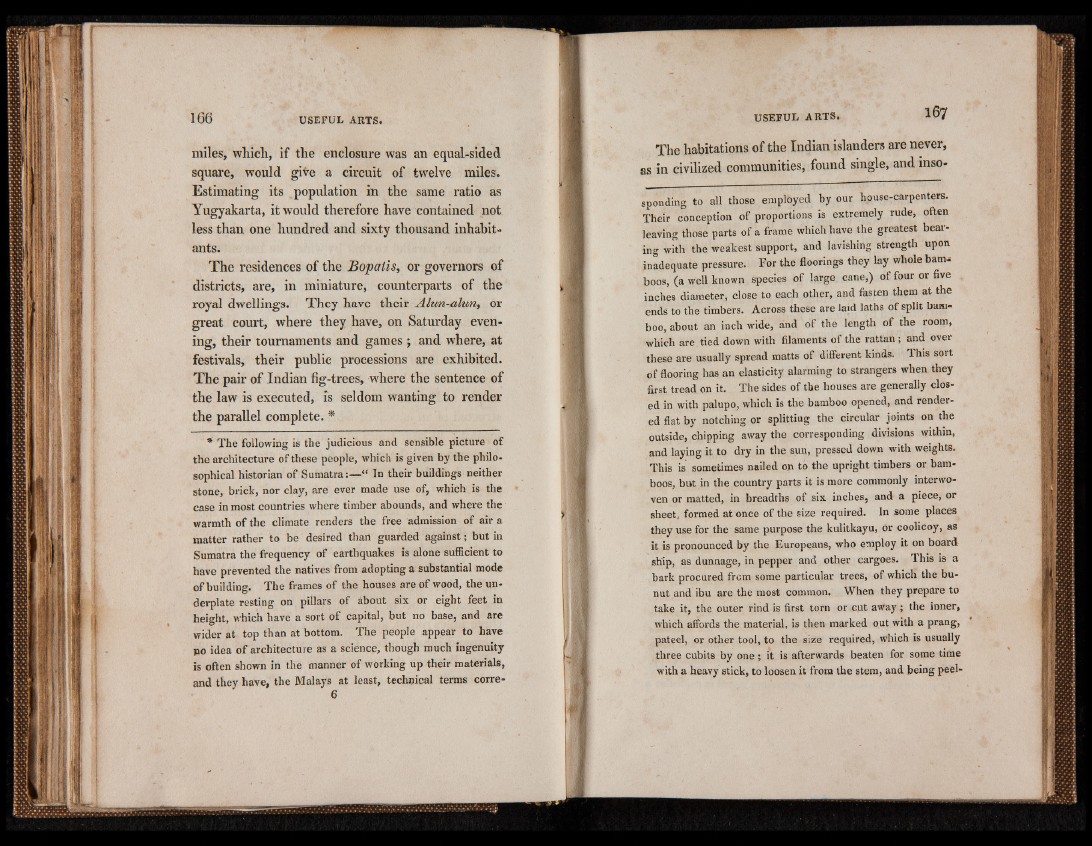
miles, which, if the enclosure was an equal-sided
square, would give a circuit of twelve miles.
Estimating its population in the same ratio as
Yugyakarta, it would therefore have contained not
less than one hundred and sixty thousand inhabitants.
The residences of the Bopalis, or governors of
districts, are, in miniature, counterparts of the
royal dwellings. They have their Alun-alun, or
great court, where they have, on Saturday evening,
their tournaments and games ; and where, at
festivals, their public processions are exhibited.
The pair of Indian fig-trees, where the sentence of
the law is executed, is seldom wanting to render
the parallel complete. *
* The Following is the judicious and sensible picture o£
the architecture of these people, which is given by the philosophical
historian of Sumatra:—“ In their buildings neither
stone, brick, nor clay, are ever made use of, which is the
case in most countries where timber abounds, and where the
warmth of the climate renders the free admission of air a
matter rather to be desired than guarded against; but in
Sumatra the frequency of earthquakes is alone sufficient to
have prevented the natives from adopting a substantial mode
of building. The frames of the houses are of wood, the underplate
resting on pillars of about six or eight feet in
height, which have a sort of capital, but no base, and are
wider at top than at bottom. The people appear to have
po idea of architecture as a science, though much ingenuity
is often shown in the manner of working up their materials,
and they have, the Malays at least, technical terms corre-
6
The habitations of the Indian islanders are never,
as in civilized communities, found single, and insosponding
to all those employed by our house-carpenters.
Their conception of proportions is extremely rude, often
leaving those parts of a frame which have the greatest bearing
with the weakest support, and lavishing strength upon
inadequate pressure. For the floorings they lay whole bamboos,
(a well known species of large cane,) of four or five
inches diameter, close to each other, and fasten them at the
ends to the timbers. Across these are laid laths of split bamboo,
about an inch wide, and of the length of the room,
which are tied down with filaments of the rattan ; and over
these are usually spread matts of different kinds. This sort
of flooring has an elasticity alarming to strangers when they
first tread on it. The sides of the houses are generally closed
in with palupo, which is the bamboo opened, and rendered
fiat by notching or splitting the circular joints on the
outside, chipping away the corresponding divisions within,
and laying it to dry in the sun, pressed down with weights.
This is sometimes nailed on to the upright timbers or bamboos,
but in the country parts it is more commonly interwoven
or matted, in breadths of six inches, and a piece, or
sheet, formed at once of the size required. In some places
they use for the same purpose the kulitkayu, or coolicoy, as
it is pronounced by the Europeans, who employ it on board
ship, as dunnage, in pepper and other cargoes. Ih is is a
bark procured from some particular trees, of which the bu-
nut and ibu are the most common. When they prepare to
take it, the outer rind is first torn or cut away; the inner,
which affords the material, is then marked out with a prang,
pateel, or other tool, to the size required, which is usually
three cubits by one ; it is afterwards beaten for some time
with a heavy stick, to loosen it from the stem, and being peel*